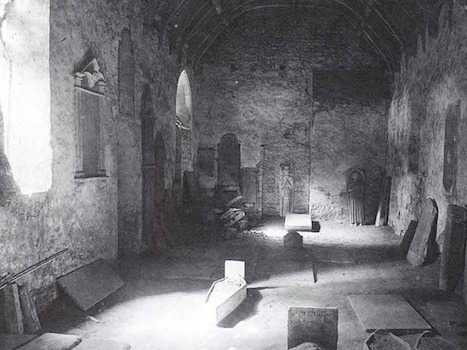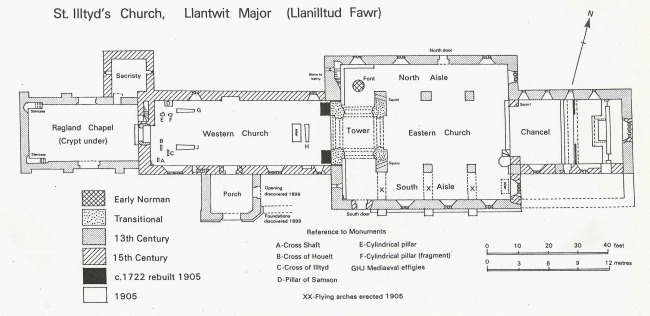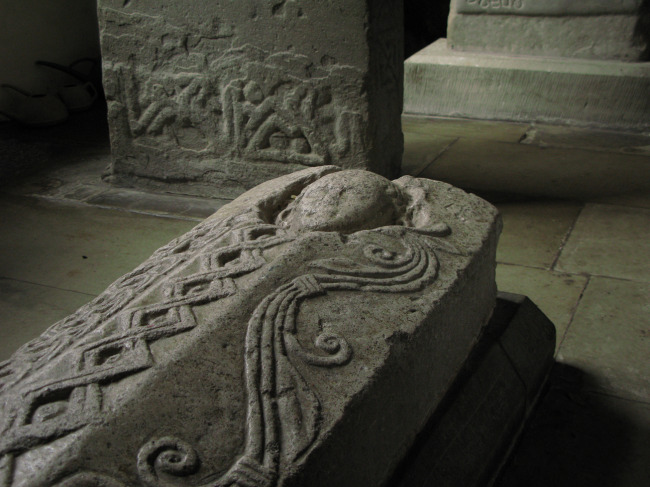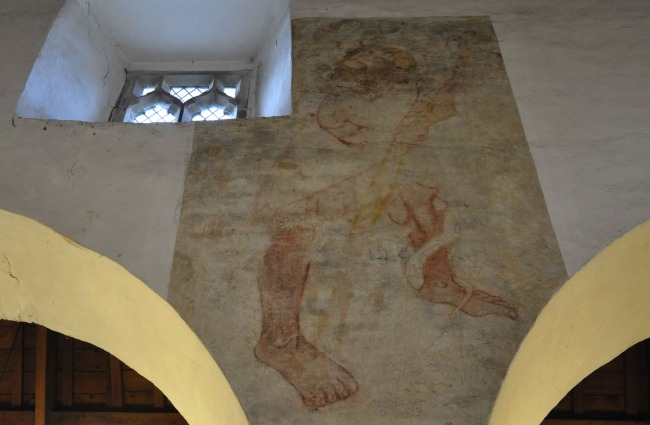The medieval church

Historically, Saint Illtud's is really two churches. The part you enter through the porch is the west church, thought to be built where the original Celtic Church stood. When you pass through the the glass doors you enter the east church an altogether more ornate structure which reveals the maintenance of faith through a wealth of memorials, monuments, murals and carvings.
Church history
The original Celtic church probably stood on the site of the west church, and this was rebuilt by the Normans around 1100, though the only existing Norman remains are the archway over the south door and some fragments of masonry. In the 13th c. the east church was built and subsequently modified in the 14th c. to include the tower. The west church was rebuilt in the 15th c. and the Galilee Chapel was added on as a chantry chapel through an endowment by Sir Hugh Raglan.

Church floor plan showing the stages in the development of the church. Note: drawn up prior to the relocation of the Celtic Stones.
Medieval treasures
The medieval church would have been very different from the present-day one. The west church was probably the parish church, while the canons worshiped in the east church. The floor was of beaten earth and there were no pews; the elderly sat on the stone benches. Nevertheless, the church had its wall paintings, altars and rood with painted statues and ornaments. It might be stretching a point to say that the interior of the medieval church would have been ablaze with colour, but it was most certainly highly decorated.
The east and west churches contain a wealth of features that are of historical interest and that help tell the story of Llanilltud in medieval times. Below are a few of our church’s medieval treasures.
The West Church
-
Medieval memorial stones – the church is a treasury of memorials, in the west church there are there are a number of ancient sepulchral slabs, either in the floor or set against the walls. Decorated with simple or ornamental crosses they probably marked the graves of monks buried inside the church.
-
Effigies – two effigies lie in the west church. The one on the south side is one of the earliest effigial slabs in the Vale of Glamorgan dating from the 13th c. On the north side is the effigy of a lady in Elizabethan costume.
-
Carved figure – above the effigy set into the north wall is small carved figure in Jacobean costume kneeling in prayer.
-
Oak roof – arch-braced with collar beam trusses featuring wooden bosses carrying the coats of arms of important Vale of Glamorgan families.

One of the earliest effigial slabs in the Vale of Glamorgan dating from the 13th c.
The East Church
-
Reredos – Elaborately carved stone screen containing 22 niches, at one time there would have been a gilded statuette of a saint or apostle in each. Only one statuette now remains, of a Virgin and Child, now located in one of the south windows. A gift of the Raglan family about 1430.
-
Font – Norman, carved in Sutton stone in a scale pattern with mouldings on rim and base of bowl.
-
Wall paintings – On the north wall there is a fine 13th c. painting of Saint Mary Magdalene holding a cup of ointment. On the north wall is a large representation of Saint Christopher, the patron saint of travellers, crossing a stream. Painted around 1400. Further east there is a representation of the Stuart royal arms with the inscription, ‘God Save King James, 1604’. There are several other badly faded paintings and some fine examples of medieval wall decoration.
-
Jesse niche – Located on the east wall near the pulpit. 13th c. carved stone representation of the ancestry of Christ. A very rare treasure, possibly the only example in Wales.
-
Stone altar – located in the Lady Chapel is a mensa, a stone altar inscribed with five consecration crosses in the corners and centre. In the 16th c. when stone altars were replaced by wooden tables it was then used as a gravestone for Katherin Thomas of ‘the Hame’.
-
Stone memorial – located below the pulpit a coffin-shaped sepulchural slab from the 14th c

Medieval wall painting depicting Saint Christopher crossing a stream painted around 1400
‘…the most beautiful as well as the most spacious church in Wales’ extract from John Wesley’s diary dated 25th July 1777